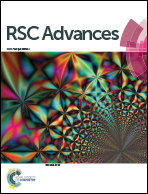Preparation and absorption behavior to organic pollutants of macroporous hydrophobic polyvinyl alcohol–formaldehyde sponges†
Abstract
A series of macroporous hydrophobic polyvinyl alcohol–formaldehyde sponges (PVF–Gn–Hms) are prepared via the reactions of hydrophilic polyvinyl alcohol–formaldehyde (PVF) sponges with glutaraldehyde (GA) and fatty acyl chloride. Both ATR-IR and solid-state CP/MAS 13C-NMR spectra confirm a successful substitution of alkyl chain on PVF sponges, and the calculated degree of substitution (DS) is in the range of 32.3–62.3%. PVF–Gn–Hms sponges have similar apparent densities as the pristine PVF sponges and exhibit a unimodal macropore size distribution with a peak centered at about 60 μm and a high porosity of 90%. PVF–Gn–Hms maintain the original open-cell structure well, and their surface hydrophobicity effectively increases with the n-alkyl chain length and reaction temperature. The effect of preparation conditions, including the feed ratio of crosslinker glutaraldehyde to OH groups ([GA]/[OH] = 0–4), alkyl chain length of fatty acyl chloride, reaction temperature and apparent density of pristine PVFs, on absorption behavior to organic pollutants is investigated extensively. Fourteen common solvents with solubility parameters from 7.24 to 13.40 cal1/2 cm−3/2 are selected as organic pollutants. Results demonstrate that the resultant PVF–Gn–Hms with a higher feed ratio of [GA]/[OH] (from 0 to 4) possess lower absorption capacities in most organic solvents because of a relatively higher crosslinking degree. The sponges prepared at higher reaction temperatures only exhibit slightly increased absorption capacities, and a relatively lower apparent density of pristine hydrophilic PVF facilitates higher absorption capacities. Definitely, the hydrophobic sponges with different apparent densities exhibit excellent reusability and recovery (up to 93.0%) during 35 successive absorption–squeezing cycles and excellent absorption selectivity in the water-organic solvent mixture experiment. More importantly, as-prepared sponges possess hydrophobic surfaces, open-cell structures, high porosity, as well as excellent reusability and selectivity, which make them ideal candidates as absorbents for organic pollutants.


 Please wait while we load your content...
Please wait while we load your content...